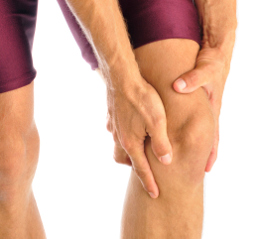Experiencing sharp knee pain with activity can result in restricted body movement. The following article explains the causes of swelling and pain behind knee. Read on, to know how to reduce the symptoms...

You can easily kneel, bend, or stretch your legs only when knees support these basic actions well. Besides helping in the leg movements, knees also bear the entire weight of your body. Even mild knee pain, if left untreated, may cost you much later. It can affect each and every activity like sitting, standing, walking, etc. Sometimes, the pain is experienced while sleeping too. Swelling is usually followed by pain and discomfort.
Common Causes of Swollen Knee
Baker's Cyst: Baker's cyst is a non-malignant growth that is usually noticed in runners and tennis players. Weakened lining of the joint can lead to the formation of a lump or swelling behind the knee, which may restrict the leg movement. It can cause pain and discomfort to the person. Rheumatoid arthritis and osteoarthritis can especially lead to the formation of Baker's cyst, causing unbearable pain.
Chondromalacia of Patella: Chondromalacia of the patella is also called "runner's knee". Swelling at the back of the knee after running (like baker's cyst) can be noticed when a runner approaches forty miles per week for the first time. Over-strain leads to such condition. Even though a few day's rest is recommended, the pain may come right back. After the first few miles of the next run, increased swelling can be noticed, and the pain also might flair up.
Injuries: A fracture or tear in your meniscus or ligaments, or just a minor tear of the cartilage surface can lead to pain and inflammation. Trauma, injury, and fracture during a sport event or accident are some of the common contributing factors for the inflammation of the joint.
Overuse: Pain is experienced when a joint is overused. Strenuous or constant exercise, wrong position during exercise or during any activity, aging, or any fault in structural alignment can cause swelling in the joint, resulting in mild or severe pain. Swelling behind the knee after exercise is a very common complaint. If a joint is not used to an exercise pattern, it may exhibit symptoms like inflammation and pain.
Weakened Muscles: Sometimes, weakened thigh, foot, or calf muscles can create unnecessary work pressure on the knees during any activity, and can lead to pain when bending. If you are overweight, then this problem can be often experienced as the knees have to carry excess weight.
Other Problems: Rubbing of the knee cap against the lowermost end of the femur (thigh bone) can cause inflammation behind the cap, and can lead to sharp pain. Sudden change in the daily routine, any added activity, lack of exercise, vitamin deficiency, and serious diseases like cancer are some of the other contributing factors for the symptoms described above.
How to Lower the Swelling and Pain
- If you are overweight, losing weight can help avoid knee problems. Regular exercises and balanced diet can help reduce the weight.
- Arthritic patients also need to perform regular exercises under the guidance of a physician or physical trainer.
- Regular runners should use perfect fitting shoes along with knee braces and additional arch support in the shoes, etc.
- Baker cyst in rare cases requires removal of excess fluid from the joint, in conjunction with cortisone injection. Your doctor may prescribe medications to relieve pain and inflammation. Mostly, Baker's cyst heals on its own and no special treatment is required.
- For mild swelling or pain, you may opt for over the counter anti-inflammatory medicines or pain killers. You can apply ice packs or hot packs, ointments, balms, etc.
- You should provide sufficient rest to the joint. You should avoid rigorous physical activities which might lead to increased pressure on the joint.
- If Baker's cyst is associated with cartilage tears or other internal knee problems then surgery can be the best treatment option. During the surgery, the surgeon can remove the swollen tissue (synovium) that is responsible for the cyst formation.
The most important thing is that you should consult your doctor for any knee problem, if it is not resolved with the help of simple home remedies.
Disclaimer: This article is for informative purposes only, and should not be substituted for the advice of a medical professional.


 You can easily kneel, bend, or stretch your legs only when knees support these basic actions well. Besides helping in the leg movements, knees also bear the entire weight of your body. Even mild knee pain, if left untreated, may cost you much later. It can affect each and every activity like sitting, standing, walking, etc. Sometimes, the pain is experienced while sleeping too. Swelling is usually followed by pain and discomfort.
You can easily kneel, bend, or stretch your legs only when knees support these basic actions well. Besides helping in the leg movements, knees also bear the entire weight of your body. Even mild knee pain, if left untreated, may cost you much later. It can affect each and every activity like sitting, standing, walking, etc. Sometimes, the pain is experienced while sleeping too. Swelling is usually followed by pain and discomfort.